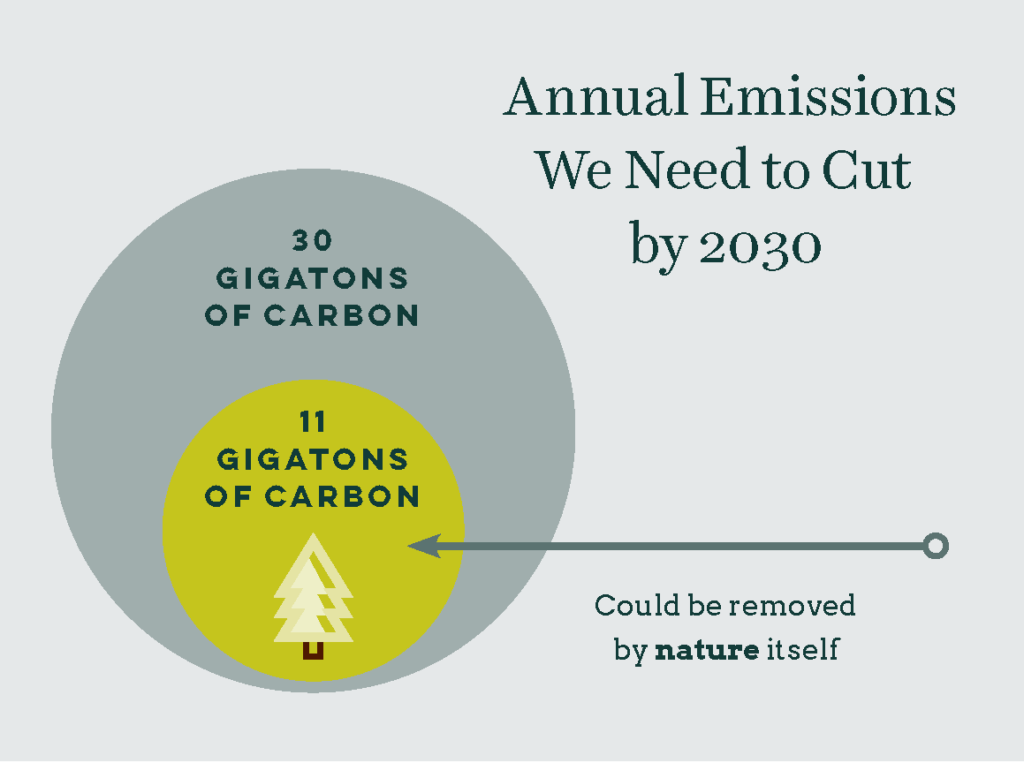Nature Knows Best
Natural climate solutions represent a key strategy to combat climate change
If you’re reading this, it’s a safe bet that you care about the environment (thank you). It’s also a safe bet that in the process of staying informed about the challenges of pollution, habitat loss, and global climate change, you’ve recently found yourself feeling overwhelmed by the sheer gravity of it all. It seems as if every day we learn how changes are happening faster and more severely than we feared even the day before.
The science is clear: we have 11 years to make sweeping changes that will keep global warming well below 2 degrees Celsius and thus avoid catastrophic consequences. The scale of both the challenge and the solutions required can be immobilizing. After all, what can one person do to make a difference?
It turns out nature may provide the most straightforward solution for us all: if protected, forests, grasslands, and other natural lands can remove carbon from the air naturally. For our part, we can each make a difference by investing in natural climate solutions, namely conserving, restoring, and better managing land.
For 30 years Columbia Land Trust has been motivated by the myriad benefits of conserving and restoring land, including clean and plentiful water, healthy air, local food, wildlife habitat, and a balance of recreation, scenic, and economic values. Today we more fully appreciate the fundamental benefits of carbon sequestration across conserved lands, and particularly in forests. “In the Pacific Northwest,” says Ian Sinks, stewardship director for the Land Trust, “forests on the west side of the Cascades are high-biomass forests—some of the best acre-for-acre carbon sinks in the world. We have big trees that can store carbon in their structures both above and below ground.”
In other words, local actions to conserve and restore our forests are a form of climate action with global significance. Currently, the Land Trust manages roughly 12,000 acres of forests and woodlands, and we anticipate conserving about 10,000 more acres in the next three years. The climate crisis, and opportunities to both store carbon and adapt to changes in the landscape, are informing our priorities around what we protect and how we manage land moving forward, blending conservation with climate solutions.
Based on a conservative estimate, the forests and woodlands conserved by Columbia Land Trust alone—not including all the wetlands and farmlands—remove 12,000 tons of carbon per year, the equivalent of taking 2,600 cars off the road. We are identifying and prioritizing more carbon-rich tracts of forest to conserve in the years ahead.
In addition, the Backyard Habitat Certification Program, which we manage with Portland Audubon, offers people in their own communities in the Portland-Vancouver metro area the resources to transform their lawns into gardens rich with shrubs and trees. The individual scale is small, but the aggregate carbon sequestration value is significant. Plus, trees in the urban landscape can offer critical shade, help clean the air, and even help manage stormwater—building resilience to increasingly severe heatwaves and floods.
Natural climate solutions add up. The Nature Conservancy estimates that we will need to cut 30 gigatons of carbon from our annual emissions by 2030 to keep global temperature increases well below 2 degrees Celsius, and roughly 11 gigatons could be removed by nature itself. We can cut one-third of current greenhouse gas emissions simply by protecting, restoring, and better managing land and water resources. This is why the IPCC’s recent report, Climate Change and Land, outlines the need for better land management across uses.
The lower Columbia River region is as diverse in its communities as it is in natural landscapes. This diversity also highlights the need for climate solutions that are fair and equitable. Rural communities of the Pacific Northwest face distinct risks from climate change, including drought, wildfires, and changes to crops and trees that can be grown. The region’s tribes and indigenous communities are seeing climate change threaten culturally important species from salmon and other First Foods to western redcedars. Communities of color and low-income communities nationwide are disproportionately affected by the impacts of climate change. In cities, the poorest areas also tend to be the hottest and vulnerable to intense storms. When we evaluate possible climate solutions, we all must work to ensure benefits and opportunities are shared fairly since the risks of doing nothing are not.
In this era of global climate disruption, relying on natural climate solutions is critical, but this alone won’t be enough. The remaining two-thirds of the global equation for averting any further climate crisis requires a rapid shift to clean energy. Such a shift will require bold changes in both policy and human behavior. Still, investing in local conservation offers an opportunity for each of us to make a real, tangible difference today.
To paraphrase author and scientist Robin Wall Kimmerer, despair robs us of our agency, but restoration—and conservation—offer an antidote to despair. We thank you for supporting conservation. When you’re feeling overwhelmed, know that by acting locally, we all can care for the lands and waters that give us so much, and make our future a lot brighter in the process.
